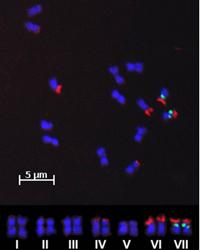The source of all genetic variation is mutation. As such, the mechanisms dedicated to maintaining the fidelity of genome replication are fundamental to biology. Genome instability is a common aspect of many diseases such as cancer, as DNA is continually altered by an array of mutagenic agents from the environment and cellular metabolism. The mechanisms that monitor and repair DNA damage are very complex, yet surprisingly very well-conserved, from single-celled microorganisms (such as yeasts), to plants, to humans.
Just as mutation is essential to evolution of new traits, and ultimately new species, variation in mutation shapes genome evolution. Molecular ecology surveys genetic variation that may underlie adaptation to new or changing habitats, mapping the patterns of variation across landscapes.

Kelley Thomas — Genome-wide mutation analysis
The Thomas Group focuses on understanding the baseline rate and pattern of mutation. The work uses diverse organisms including Yeast, Nematodes and Paramecium that have been raised for many generations in the laboratory in the near absence of natural selection. In this approach many lineages are derived from a single progenitor and grown for hundreds of generations in parallel. In each lineage the organisms accumulate mutations that might otherwise be weeded out by natural selection. By sequencing the genomes of the descendants and comparing their genomes we can identify virtually all the mutations across the genome and describe their rates and patterns.
W. Kelley Thomas
Gregg Hall, Room 448
Phone: (603) 862-2470
Email: kelley.thomas@unh.edu

Matthew MacManes — Functional genomics in non-model organisms
Work in the MacManes lab centers around the basic theme of adaptation. The systems we use to better understand the eco-evolutionary forces driving pattern are varied, but two main systems form the core of the lab.
I am studying this phenomenon in captive animals. I house these animals in desert conditions, understand their physiology by analysis of blood and urine. I measure gene expression via high throughput sequencing experiments.
Adaptation to deserts: Deserts are extremely hot and dry. Animals living there must be able to endure such harsh condition. Short-lived animals — e.g., mice — may live their entire lives without ever drinking water, yet they thrive! Understanding how they do it is a main focus of the lab.
Color polymorphism in dendrobatid frogs: With collaborators (Rasmus Nielsen, Kyle Summers, Cori Richards) we are attempting to understand (1) the development and of color, and (2) its maintenance in populations.
Matthew MacManes
Gregg Hall, Room 434
Phone: (603) 862-4052
Email: matthew.macmanes@unh.edu
Kevin Culligan — Molecular and cellular responses to DNA damage
Kevin Culligan's research is focused on the molecular and cellular response to DNA damage in the model plant Arabidopsis thaliana. DNA damage occurs from both exogenous (environmental) sources such as UV light, and endogenous sources such as reactive oxygen produced during metabolism. Detected cellular DNA damage initiates a cascade of signaling events within the cell to determine the most appropriate response. For example, is it better for the cell to induce repair of the DNA damage and risk mutation, or simply induce programmed cell death if damage is too great. Kevin’s research group studies the molecular pathways of these cellular life-and-death decisions, including the protein kinases ATR and ATM, which are master regulators of the DNA damage response in eukaryotic cells. Both genetic and genomic approaches are currently being used in the lab to study these pathways.
Kevin Culligan
Rudman Hall, Room 310
Phone: (603) 862-2430
Email: k.culligan@unh.edu

Thomas M. Davis — Genome Structure and Evolution in Crop Plant
We aim to understand how genome structure evolves as a consequence of hybridization and polyploidization in crop plants (with current emphasis on strawberry), and to establish knowledge and resources needed to enable marker-assisted selection by plant breeders. Approaches include whole genome sequence, bioinformatics, site-specific resequencing and phylogenetic analysis, molecular cytogenetics, germplasm exploration and development, transmission genetics, and linkage mapping.
Thomas M. Davis
Rudman Hall, Room 104
Phone: (603) 862-3217
Email: tom.davis@unh.edu

Adrienne Kovach — Molecular ecology and conservation genetics of vertebrates
Research in the Kovach lab is focused on the application of genetic approaches to the population ecology, evolution and conservation of vertebrates. We address questions about population and stock structure, dispersal, source-sink dynamics, interspecific hybridization, landscape genetics and conservation genetics in a variety of vertebrate species, including black bears, New England cottontails, Saltmarsh Sparrows, vernal pool-breeding amphibians, and marine and anadromous fish. We typically combine field studies of behavior and ecology with genetic approaches, including microsatellite or SNP genotyping and DNA sequencing. A primary current focus is in elucidating anthropogenic influences on population structure and dispersal, for example, the effects of habitat fragmentation and suburban development on animal dispersal and metapopulation dynamics. Some projects also employ a population genomics approach, whereby next generation genomic sequencing technologies facilitate studies of adaptive variation in natural populations
Adrienne Kovach
Rudman Hall, Room G87
Phone: (603) 862-1603
Email: adrienne.kovach@unh.edu